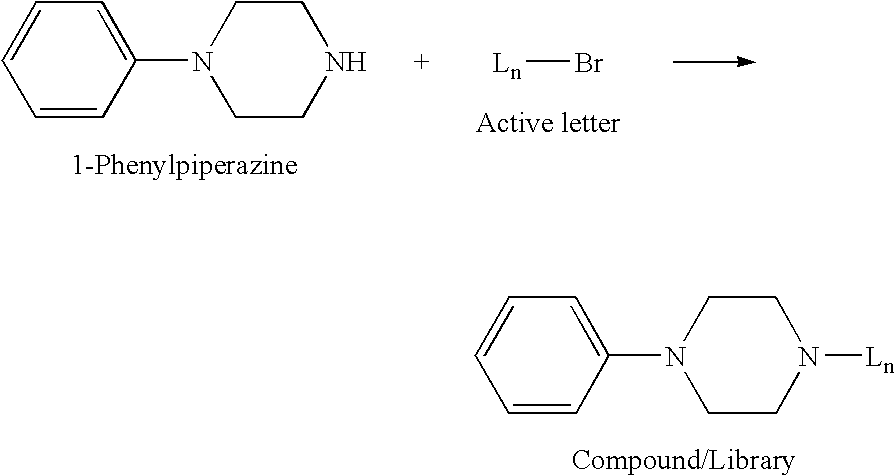Nucleobase heterocyclic combinatorialization
- Summary
- Abstract
- Description
- Claims
- Application Information
AI Technical Summary
Benefits of technology
Problems solved by technology
Method used
Image
Examples
example 1
tert-Butyl-1-piperazinecarboxylate
[0144]Piperazine (236 g, 2.75 mmol, 6 eq.) was suspended in acetonitrile (1.8 L) in a three neck round bottom flask fitted with a mechanical stirrer and diisopropylethylamine (87.96 mL, 504 mmol) was added. Di-tert-butyldicarbonate was dissolved in acetonitrile (200 mL) and added to the reaction mixture via dropping funnel. A white precipitate formed overnight which was filtered, washed twice with acetonitrile (50 mL) and dried in vacuo. The filtrate was concentrated in vacuo and additional white precipitate (piperazine) was filtered from the reaction mixture. The filtrate was reduced in volume in vacuo and partitioned between water and hexane (100 mL / 100 mL). The water was extracted twice with hexane (100 mL). The hexane layers were pooled, washed with brine (100 mL), dried (MgSO4) and concentrated in vacuo to give 66.32 g (79%) of the title compound. 1H NMR (CDCl3): δ 1.45 (s, 9H), 2.79 (t, 4H), 3.38 (t, 4H).
example 2
N1-t-Boc-N-2-α-bromoacetylpiperazine
[0145]tert-Butyl-1-piperazinecarboxylate (10 g, 53.69 mmol) was dissolved in tetrahydrofuran (250 mL) and diisopropylethylamine (10.29 mL, 59.06 mmol) was added. The reaction mixture was cooled in an ice bath for 20 minutes and bromoacetyl bromide (5.13 mL, 59.06 mmol) was added. The reaction progress was monitored by thin layer chromatography using MeOH:CH2Cl2 (5 / 95, v / v) which showed disappearance of starting material and formation of a new UV active product spot after 20 hours. The reaction was partitioned between water and CH2Cl2 (100 mL / 100 mL), separated, and the aqueous layer was extracted twice with CH2Cl2 (100 mL). The organic layers were pooled and washed with brine (100 mL), dried (MgSO4), filtered and concentrated. The resulting residue was purified by silica gel flash column chromatography using MeOH:CH2Cl2 (5 / 95, v / v) as the eluent. The appropriate fractions were pooled and concentrated to give 10.63 g (66%) of the title compound. 1H...
example 3
N1-(Trimethylsilylethoxycarbonyl)piperazine
[0146]Piperazine (36.48 g, 423 mmol) was dissolved in acetonitrile (1 L) and 2-(trimethylsilyl)ethyl-p-nitro-phenylcarbonate in acetonitrile (500 mL) was added via a dropping funnel. The reaction progress was monitored by thin layer chromatography using MeOH:CH2Cl2 (10 / 90, v / v) which showed disappearance of starting material and formation of a new product spot after 20 hours. The acetonitrile was evaporated to a yellowish residue. The residue was partitioned between water (600 mL) and hexane (100 mL). After separation the water layer was extracted twice with hexane (100 mL). The hexane layers were pooled, dried (MgSO4), filtered, and evaporated to give 15.24 g (94%) of the title compound. 1H NMR (CDCl3): δ 0.02 (s, 9H), 0.99 (t, 2H), 1.79 (bs, NH), 2.80 (t, 4H), 3.41 (t, 4H), 4.26 (t, 2H).
PUM
 Login to View More
Login to View More Abstract
Description
Claims
Application Information
 Login to View More
Login to View More - R&D
- Intellectual Property
- Life Sciences
- Materials
- Tech Scout
- Unparalleled Data Quality
- Higher Quality Content
- 60% Fewer Hallucinations
Browse by: Latest US Patents, China's latest patents, Technical Efficacy Thesaurus, Application Domain, Technology Topic, Popular Technical Reports.
© 2025 PatSnap. All rights reserved.Legal|Privacy policy|Modern Slavery Act Transparency Statement|Sitemap|About US| Contact US: help@patsnap.com



